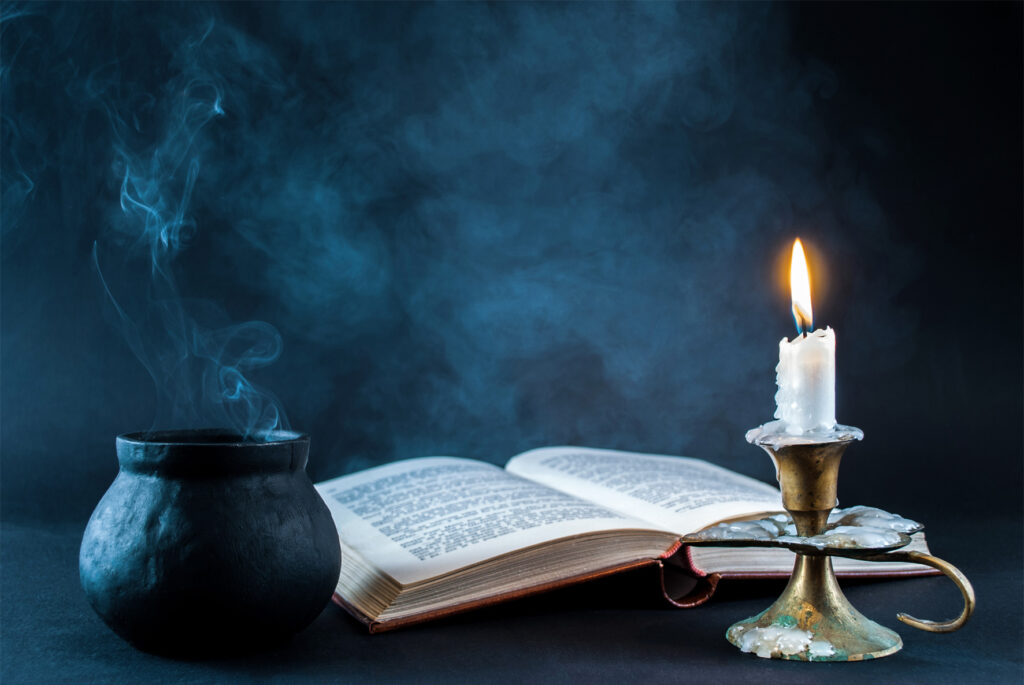What is the difference between a witch and a saint?
What is the difference between a witch and a saint?
Religions strictly discriminate between witches and saints, although their supernatural activities significantly overlap. Why are some celebrated while others are demonised? What is the difference between a witch and a saint?
In the French TV series ‘Ainsi soient-ils’,[1] a priest with cancer lying in a hospital bed is surprised to feel much better after a nurse placed her hands on his chest and transferred her energy into his body. Not knowing how it worked but grateful for the healing, he relies on her for easing the pain of the therapy. Once his cancer is in remission, he successfully tries to help others by laying his hands on them. While the nurse had to keep her power a secret in order to not lose her job, his success is renowned.
While Protestantism recognises anyone who believes in God’s grace as a saint, most Christian, Muslim, and Jewish confessions define saints as extraordinary people. The Torah uses the term qadosh, meaning ‘separate’ (for God). The ‘miraculous power’[2] of a person towards virtue is often enough. The Roman Catholic Church however demands that candidates for canonisation are responsible for at least two significant miracles.[3] Saints’ and sorcerers’ healing activities are similar. Still, one is portrayed as a witch while the other is represented as a saint. So, what distinguishes witches from saints? Gender obviously plays a role. Women who make changes happen by summoning supernatural forces are more often demonised than men who do the same.[4] But this was not always the case.
The first accusations of sorcery affected all pagans
Monotheistic religions condemned sorcery very early on. Judaism accused all pagans. All believers who acknowledged other Gods than the God of Judaism were said to be sorcerers.[5] Judaism forbade magic.[6] French Bible scholar Thomas Römer states that the political context accounts for this early prohibition. In the 7th century B.C., he explains, king Josias centralised all powers. All legitimate political, economic, and religious authorities were gathered in Jerusalem. As a consequence, any ritual that was carried out outside the official clergy became suspect. Sorcery was not only a threat to the established religion; it was a provocation of the king.[7] Römer adds that geopolitical reasons played a role too. In the Tanakh (i.e approximately what Christians call ‘Old Testament’), Egyptian and Mesopotamian priests are presented as sorcerers and chamans. The rivalry between nations took place not only on battlefields, but also in the field of religion. Priests confronted each other, or rather, they let their Gods defy each other in ‘magic overbids’.[8]
Any supernatural activity that did not serve God was called evil
Christianity and Islam agree there is real power in witchcraft. But if the originator and beneficiary of this power is said to be evil, their perpetrators are demonised and cast out.[9] They properly become heretics.[10]
Behaving like any other sect leader[11] of his time, Jesus frequently performed healing miracles.[12] After he died, the writers of the New Testament tried to justify his gestures, explaining he worked them to show that he was the son of God, rather than to fulfill anyone’s expectations.[13] Christianity kept rejecting pagan sorcery while using magic rituals to attest to the mightiness of its God. Sorcery became criticised when it was practical and served no greater purpose than the improvement of current life.[14] For, if it does not serve God, it must serve the devil. Islamic teachings perpetuated and developed this definition of witchcraft. In the Quran, sorcery and magic are referred to as ‘sihr’.[15] It is nothing compared to the almightiness of Allah,[16] but practicing it brings one closer to the devil. Sihr is therefore a capital sin.[17]
In the Renaissance, witch hunts targeted dissenters
In Europe, the rejection of witches grew through the Middle Ages, peaking during the Renaissance.[18] Witch hunts became massive during the European religious wars between Catholicism and Protestantism, says historian Robert Muchembled. The connection between these two killings, he explains, was the fear induced by multiple and violent divisions within Christianity. After the Reformation, Jesuits[19] theorised the existence of a hidden human sect that adored Satan and desired to destroy God’s creation. In order to prove they sided with God, Catholics and Protestants rivaled in prosecuting as many suspicious people as they could.[20] Anyone who seemed to be a political or religious dissenter, or simply different-looking – whether too old, too charming, or too crippled – could be called a witch. As it turned out, women seemed more dubious than men.[21] Re-imagining the persecutions of witches at that time, Victor Hugo wrote the famous Hunchback of Notre Dame.[22] In the story, three characters were potential sorcerers: the archdeacon Frollo who was odd and menacing, the hunchback Quasimodo who looked different from able-bodied people, and the Egyptian street performer Esmeralda.[23] The beauty of Esmeralda, her foreign origins, her naïvety, and fierce chastity were the most unbearable to Frollo (who, in the story, stands for the Catholic Church). She was the one prosecuted, although her only two activities were to dance and train her circus goat.[24] Esmeralda’s story is but one example of the targeting of women at a time of religious crises.
Witches today are self-determined and feminist
The ambiguity of the word ‘charm’ is no coincidence. Seducing and bewitching people progressively became the main crime of witchcraft. To the point where sorcery was related to atypical femininity.[25] Today, feminists call themselves witches, commemorating the century-long persecution of those who did not fit the norms of femininity: wrinkly, grey haired, shapely, unmarried, knowledgeable, self-sustaining, or self-confident. “We are the granddaughters of the witches you weren’t able to burn”[26] is a slogan for younger generations of women’s rights activists. Deliberately identifying as a witch means resisting the male gaze,[27] embracing the heritage of dissident women from the past,[28] and emancipating from religious control over female bodies.[29] The slander is thus reversed into praise and political claim.
Celebrating Halloween as a believer
So what is the difference between witches and saints? Not the supernatural nature of their activities. Rather, it is their degree of ‘normalcy’ in the political and religious systems of their time that determines if they are celebrated or persecuted. Belonging to foreign or inferiorised groups is the main reason why healers and magicians are called witches. Religions forged the notion of witchcraft and appointed culprits. Pagans, heretics, and women were excluded and killed, because they were said to bring evil into the world.[30]
Religions no longer set the standards of acceptability. In particular, feminist movements have reclaimed the notion of witchcraft. This highly religious notion has become secular. Still, some keep rejecting any entertainment that contains magic, be it fictional and a-religious. Among other precautions, Christians, Jews, and Muslims are all prompted to avoid Halloween celebrations[31] and Harry Potter movies[32] as evil seductions. This reluctance to enjoy fantastic narratives could be lessened, considering the proximity between saintity and witchcraft.
Want to read more about similar topics? Go to the EARS Dashboard and get free weekly updates.
[1] Ainsi soient-ils – Séries et fictions | ARTE (available in French and German)
[2] John Stratton, Saints and Virtues, University of California Press, 1987
[4] Mona Chollet, Sorcières. La puissance invaincue des femmes, La Découverte, 2019
[5] Virginie Roussel, Monothéismes. Dieu seul connaît la formule, Le Monde des Religions, juillet-août 2018
[6] Devarim/Deuteronomy 18, 10-12: “There shall not be found among you anyone who burns his son or his daughter as an offering, anyone who practices divination or tells fortunes or interprets omens, or a sorcerer or a charmer or a medium or a necromancer or one who inquires of the dead, for whoever does these things is an abomination to the Lord. And because of these abominations the Lord your God is driving them out before you.”
[7] Thomas Römer, Les interdits des pratiques magiques et divinatoires dans le livre du Deutéronome, In Magie et divination dans les cultures de l’Orient, Editions Jean Maisonneuve, 2010, Available here
[8] For example, the prophet Elija forces the rain to stop falling (Book of Kings), and Aaron transforms Nile River’s water into blood (Book of Exodus).
[9] Colette Arnould, Histoire de la sorcellerie, Editions Tallandier, 2019
[10] Although the notion of ‘heresy’ is christiano-centered and does not exactly replicate in Judaism and Islam. Matthieu Terrier, L’hérésie, un concept transposable?, Archives de sciences sociales des religions, 2018
[11] ‘Sect’, in this early period of time, referred to what we today call ‘religious denomination’.
[13] John 20, 30-31: “Jesus performed many other signs in the presence of his disciples, which are not recorded in this book. But these are written that you may believe that Jesus is the Messiah, the Son of God, and that by believing you may have life in his name.”
[14] Magali Jenny, Guérisseurs, rebouteux et faiseurs de secret en Suisse romande, Favre, 2008
[15] Islamic Terminology — Sihr (Arabic: سحر) is the arabic word for magic or…
[16] Surat Al-Baqarah (The Cow) verse 102 – سورة البقرة : “And they followed what the devils had recited during the reign of Solomon. It was not Solomon who disbelieved, but the devils disbelieved, teaching people magic and that which was revealed to the two angels at Babylon, Harut and Marut. (…) But they do not harm anyone through it except by permission of Allah.”
[17] Sahih Muslim 89 – The Book of Faith – كتاب الإيمان
[18] Robert Muchembled, Sorcières, justice et société aux XVIè-XVIIè siècles, Editions Imago, 1987
[20] Robert Muchembled, Sorcières, justice et société aux XVIè-XVIIè siècles, Editions Imago, 1987
[21] Colette Arnould, Histoire de la sorcellerie, Editions Tallandier, 2019
[22] Victor Hugo, Le bossu de Notre-Dame, Charles Gosselin, 1831
[23] Muguraş Constantinescu, Figures de la sorcière chez Hugo, Cahiers de Recherches Médiévales et Humanistes, 2004, Available here
[24] As Muguraş Constantinescu explains, Esmeralda appears to be primitive. She talks to her goat and considers it as her ‘sister’. In Hugo’s story, even the goat was sued for sorcery, since it was ‘bewitched’. It is interesting that Hugo added this animal character. Animism was indeed one of the beliefs that churches criticised in sorcery. Still today, this criticism stands, as contemporary witches find their knowledge and power in nature.
[25] Mona Chollet, Sorcières. La puissance invaincue des femmes, La Découverte, 2019
[26] Quote from Tish Thawer, The Witches of BlackBrook, Amber Leaf Publishing, 2015
[28] Barbara Ehrenreich, Deirdre English, Witches, Midwives, and Nurses. A History of Women Healers, The Feminist Press, 1972
[29] Silvia Federici, Caliban et la sorcière. Femmes, corps et accumulation primitive, Éditions Senonevero, 2014
[30] The mythology of Eve (Unknown authors, Book of Genesis) and Pandora (Hesiod, Works and Days) are variations on this same theory of the introduction of evil.
[32] Religious debates over the Harry Potter series – Wikipedia






